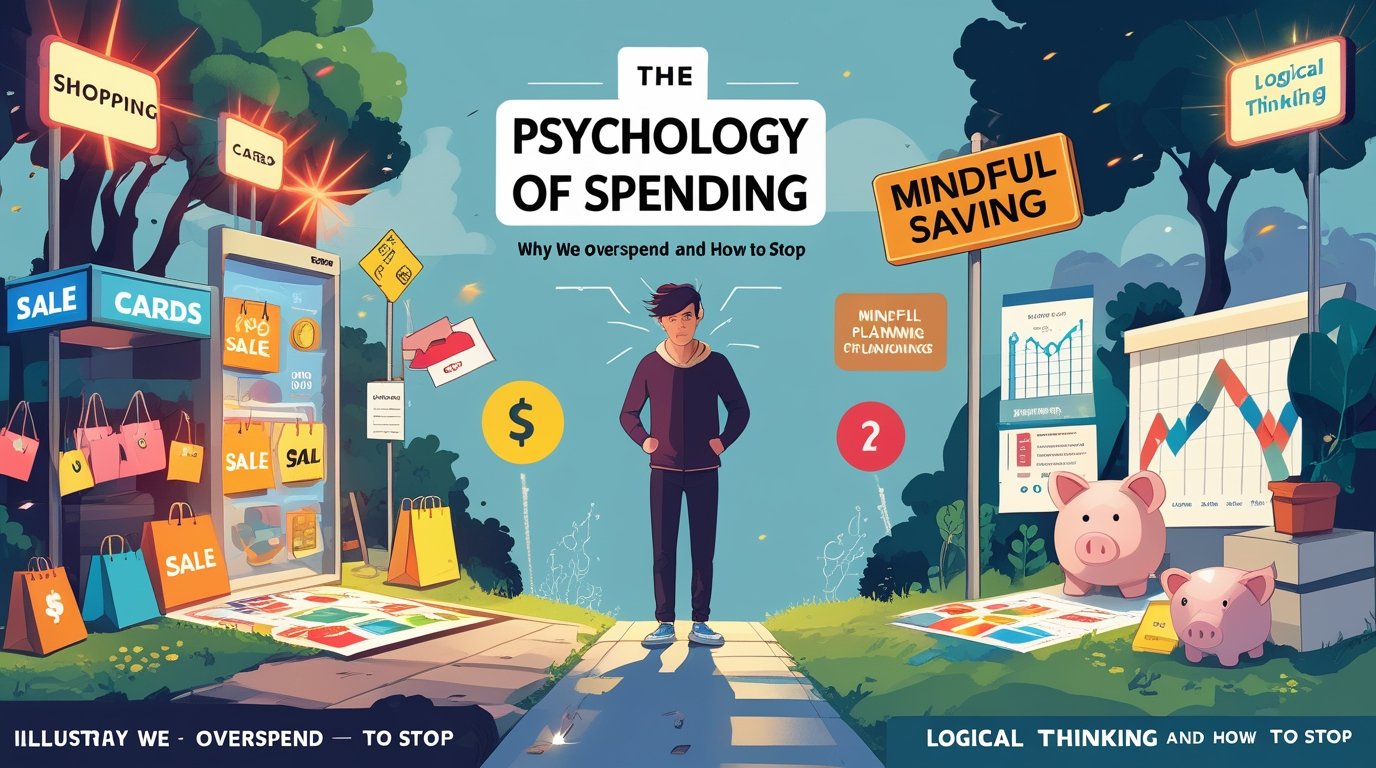Have you ever checked your bank account and wondered where all your money went? You’re not alone. The psychology of spending reveals that our brains are wired to make impulsive financial decisions, often driven by emotions, habits, or societal pressures. In 2025, with rising costs and endless online shopping temptations, overspending is a growing issue. This article dives into why we overspend, backed by psychological insights, real-world examples, and actionable strategies to regain control of your finances. Whether you’re battling retail therapy or mindless subscriptions, you’ll find practical tools to stop overspending and build healthier money habits.
The Psychology Behind Overspending
Overspending isn’t just about money—it’s about how our brains process decisions. Psychological triggers, cognitive biases, and emotional states play a massive role in our spending habits.
1. Emotional Spending
Emotions like stress, boredom, or sadness often lead to impulsive purchases. This phenomenon, known as retail therapy, temporarily boosts dopamine but leaves us with buyer’s remorse.
- Example: After a tough workday, Jane buys a $200 dress to feel better, only to regret it later.
- Why It Happens: The brain seeks instant gratification to cope with negative emotions.
2. The Diderot Effect
Named after French philosopher Denis Diderot, this effect describes how one purchase leads to a spiral of additional spending to maintain consistency.
- Case Study: Tom buys a new couch, then feels compelled to upgrade his curtains, rug, and coffee table to match, spending $2,000 more than planned.
3. Social Pressures and FOMO
Fear of missing out (FOMO) drives us to spend to keep up with peers or trends, especially on social media.
- Example: Seeing friends post about luxury vacations, Sarah books a $3,000 trip she can’t afford.
4. Cognitive Biases
- Anchoring: We compare prices to a reference point, like a “sale” price, making a $100 item seem like a bargain when marked down from $200.
- Sunk Cost Fallacy: We continue spending on something (e.g., subscriptions) because we’ve already invested in it.
Suggested Visual: An infographic showing how emotions, social pressures, and biases lead to overspending.
Why Overspending Is Worse in 2025
The digital age amplifies overspending triggers. Here’s what’s new in 2025:
- One-Click Purchases: Apps like Amazon and Apple Pay make spending frictionless.
- Subscription Overload: Streaming, fitness apps, and meal kits add up quickly.
- Influencer Marketing: Social media influencers promote aspirational lifestyles, fueling FOMO.
- AI-Personalized Ads: Algorithms target our preferences with unnerving accuracy.
Table: 2025 Spending Traps
| Trend | Impact | Example |
|---|---|---|
| One-Click Purchases | Reduces decision-making time | Amazon’s Buy Now button |
| Subscription Overload | Recurring charges drain budgets | Netflix, Spotify, HelloFresh |
| Influencer Marketing | Encourages aspirational spending | Instagram travel influencers |
| AI-Personalized Ads | Targets specific desires | Tailored ads for gadgets |
How to Stop Overspending: Actionable Strategies
Breaking the cycle of overspending requires understanding your triggers and adopting practical habits. Here are proven strategies to regain control.
1. Track Your Spending
Use budgeting apps like YNAB or Mint to monitor where your money goes.
- How to Do It:
- Categorize expenses (e.g., groceries, entertainment).
- Set weekly or monthly spending limits.
- Review your spending patterns weekly.
- Case Study: Mike, a 30-year-old freelancer, used YNAB to track his $1,500 monthly spending. He cut $300 in unnecessary subscriptions within two months.
2. Practice the 24-Hour Rule
Before making non-essential purchases, wait 24 hours to avoid impulse buying.
- Example: Lisa added a $150 pair of shoes to her cart but waited a day. She realized she didn’t need them and saved the money.
3. Unsubscribe and Declutter
Audit your subscriptions and cancel those you rarely use.
- Steps:
- List all recurring charges (e.g., streaming, gym memberships).
- Use apps like Rocket Money to identify forgotten subscriptions.
- Redirect savings to an emergency fund.
4. Set Financial Goals
Clear goals, like saving for a vacation or paying off debt, make it easier to resist overspending.
- How to Start:
- Use the SMART goal framework (Specific, Measurable, Achievable, Relevant, Time-bound).
- Example: “Save $5,000 for a car by December 2025.”
- Track progress with apps like Goalsetter.
5. Limit Social Media Exposure
Reduce time on platforms that trigger FOMO or showcase aspirational lifestyles.
- Tips:
- Unfollow influencers who promote excessive spending.
- Use apps like Freedom to block distracting apps.
- Focus on content that inspires frugality, like The Minimalists.
Internal Link: Learn more about budgeting tips here.
Pros and Cons of Common Budgeting Tools
| Tool | Pros | Cons |
|---|---|---|
| YNAB | Detailed budgeting, goal tracking | Monthly fee ($14.99) |
| Mint | Free, syncs with bank accounts | Ads and upselling |
| Rocket Money | Subscription management | Limited free features |
| Goalsetter | Goal-focused, kid-friendly | Less comprehensive for budgeting |
FAQ Section: Your Questions About Overspending Answered
Why Do I Feel Guilty After Spending Money?
Guilt often stems from cognitive dissonance—when your spending doesn’t align with your financial goals or values. For example, if you value saving but splurge on a luxury item, you may feel regret. To address this, create a budget that includes “fun money” for guilt-free spending. Track expenses with apps like Mint to stay aware of your habits. Reflect on purchases: Were they planned or impulsive? Over time, aligning your spending with your priorities reduces guilt and builds confidence in your financial decisions.
How Can I Stop Impulse Buying Online?
Impulse buying is fueled by easy access and emotional triggers. Use the 24-hour rule: Add items to your cart but wait a day before checking out. Disable one-click purchasing on platforms like Amazon. Unsubscribe from promotional emails to reduce temptation. Set a monthly “wants” budget (e.g., $50) to satisfy cravings without derailing your finances. Finally, use browser extensions like Honey to find deals, ensuring you’re not overspending on impulse buys.
What Are the Best Apps for Controlling Spending in 2025?
Top apps include YNAB for detailed budgeting, Mint for free tracking, and Rocket Money for subscription management. YNAB’s zero-based budgeting assigns every dollar a purpose, ideal for disciplined savers. Mint syncs with your accounts for real-time insights but includes ads. Rocket Money excels at identifying and canceling unused subscriptions. Choose based on your needs: YNAB for planning, Mint for simplicity, or Rocket Money for subscription control. Always check app reviews on Capterra before committing.
How Does Social Media Influence My Spending Habits?
Social media fuels FOMO and comparison, pushing you to buy to “keep up.” Influencers showcase curated lifestyles, triggering aspirational spending. To combat this, limit screen time using apps like Freedom. Curate your feed by following frugal or financial education accounts, like ChooseFI. Avoid platforms during vulnerable moments, like after a bad day. Track how often social media prompts purchases—awareness is the first step to breaking the cycle.
What’s New in 2025: Financial Tools and Trends
- AI Budget Coaches: Apps like Cleo use AI to analyze spending and offer personalized advice.
- Gamified Savings: Platforms like Qapital make saving fun with challenges and rewards.
- Crypto Spending: Some retailers now accept crypto, tempting impulsive purchases.
- Mindful Finance Apps: Apps like Daylight focus on mental health and money habits.
Conclusion: Take Control of Your Spending in 2025
The psychology of spending reveals why we overspend—emotions, social pressures, and cognitive biases drive impulsive decisions. By tracking expenses, setting goals, and limiting triggers like social media, you can break the cycle. In 2025, tools like YNAB, Mint, and Rocket Money make it easier to stay on track. Start small, stay consistent, and align your spending with your values for long-term financial freedom.
What’s your biggest spending trigger? Share your story in the comments or sign up for our newsletter for more money-saving tips!

